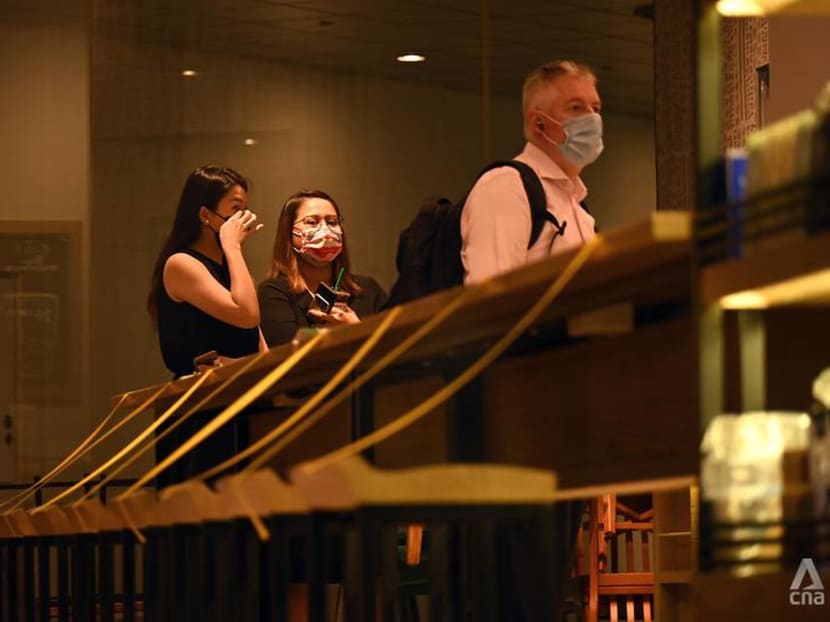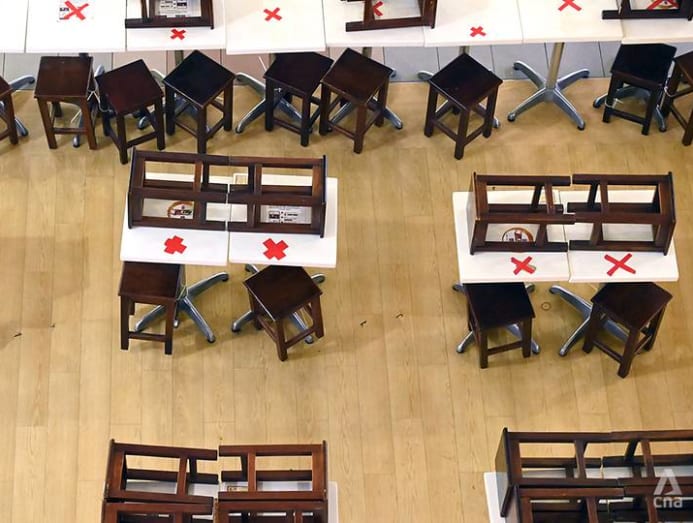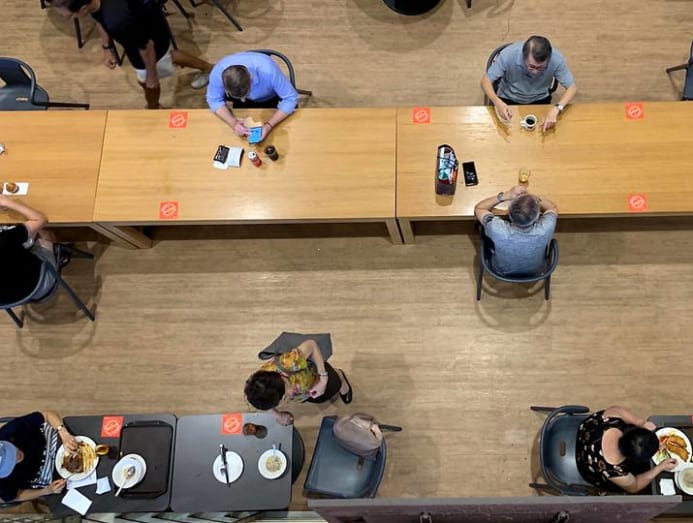F&B veterans brace themselves for new rules when dining-in reopens
The latest curbs have dealt yet another blow to eateries struggling to find their footing. Two F&B operators speak to CNA’s Heart of the Matter podcast on what worries them when dining opens again.

Customers wait around in a coffee shop by cordoned off tables and chairs to collect their orders on Monday (May 17), the second day of Phase 2 (Heightened Alert). (Photo: Gaya Chandramohan)
SINGAPORE: When dining finally reopens – currently planned for Aug 18 when the current Phase 2 (Heightened Alert) curbs are set to end – F&B owners said their biggest worry is managing crowds when they have to check who is vaccinated or not.
“We are sandwiched”, said Ya Kun Kaya Toast’s director of branding and market development Jesher Loi.
“If the Government enforces, we will have to abide by that. So, we will make adjustments. We will have to check your app … and also there will be ambassadors around who will either insist or assist.”
Speaking on CNA’s Heart of the Matter on Thursday (Jul 29), Mr Loi said he foresees huge challenges if his lean staff have to respond dynamically from behind the counter.
In his experience, customers tend to look for a table first while one person in the dining group queues for their order. But F&B operators must ensure all of them have their temperatures checked and cannot make exceptions.
READ: ‘Too many established names have fallen’: F&B industry group calls for more support from authorities
Each situation can vary, he explained, adding that it also depends on the outlet layout, the group size and whether the store is busy.
“I can feel my stress levels rising ... dealing with hostile customers and people who have their interpretations of the rules," said chef-owner of Summer Hill restaurant, Anthony Yeoh, also on the podcast.
“Tempers tend to flare up a lot more easily nowadays. It's always trying to find the right balance and still creating a good experience for customers. That's what restaurants ultimately are about,” he added.
The patience of F&B staff too will be tested. “From the customer's perspective, it's our first time to the restaurant, it's our first time being told, redirected or told to go back to the line again. But from the staff’s perspective, you could be the 40th person, the 60th person," Mr Loi said.
This is why he is appealing for customers to be understanding should there be delays, especially during peak hours. “Customer participation is critical. The vast majority of them are cooperative but sometimes they misunderstand and say, ‘I was here first’. And you get hostilities at our level on the ground.”
Mr Yeoh said he hopes the rules are kept clear and simple, else businesses will find “that at some point it's not worthwhile for the business to risk breaking the law”.
The F&B sector in Singapore has been hit by COVID-19 restrictions many times over the past year, beginning with a circuit breaker in April last year, to finally opening up to five diners in June 2020, then gradually increasing to eight diners in December 2020.
As community cases began to rise this year, group sizes were reduced to five in the beginning of May. But on May 16, Phase 2 (Heightened Alert) kicked in and dining-in was banned once again.
As vaccinations increased, dining-in reopened in late June, only to shut with the sharp rise of cases in the community arising from the KTV and Jurong Fishery Port clusters.
READ: Commentary: TraceTogether and SafeEntry were never foolproof in averting recent fishery port and KTV clusters
Most recently, co-chair of the multi-ministry task force Lawrence Wong said on Monday (Jul 26) that authorities planned to review easing restrictions in early August and potentially requiring anyone who wants to head to a restaurant, a gym or a large event to be fully vaccinated.
(Listen to the full interview with Summer Hill’s Anthony Yeoh and Ya Kun Kaya Toast’s Jesher Loi on CNA’s Heart of the Matter podcast.)
A ROLLER-COASTER RIDE
On the one hand, both agreed the latest curbs were not unexpected. Having become used to shut-downs, their staff had a “mechanic, even automatic response” – chaining up chairs, placing stickers on tables, cancelling orders with suppliers and everyone pivoting quickly towards delivery and takeaway.
But they said morale was poor.
"Everybody kind of knew their roles because we've been through this so many times. But it's just that feeling of “here we go again”. You can feel the frustration and the fatigue has set in not just for our team, but also for our customers as well," Mr Yeoh pointed out.
Agreeing, Mr Loi said when shutdowns first happened, things were far more chaotic. He had to worry about staff deployment, ensuring full timers were kept on the payroll and figuring out how those who couldn’t be cross deployed could still work or take leave if they wanted to.

Now, with most frontline staff vaccinated and with quick testing, things are far more predictable. “But there's just no energy, there is no optimism, there was no solidarity or hope,” he confessed.
Still, both recognise they may be more fortunate than others in the sector. “We are able to do takeaways and are on food delivery platforms, unlike say a café that sells ice-cream, they can’t do delivery," said Mr Loi.
Should there be different levels of support then for F&B operators? “It’s not an easy task for the Government because they lump F&B together, they call F&B as one category registered under ACRA (Accounting and Corporate Regulatory Authority) but there’s kiosks, take-aways, cafes and you go all the way upstream to restaurants and fine dining ... there are sub-categories within categories,” Mr Loi said.
READ: Commentary: Does Singapore just have too many F&B outlets?
If there was a big lesson throughout these months of open and shut restrictions, it was ensuring they had a buffer of resources to draw from.
For Summer Hill, the latter half of last year saw brisk business as people came out to dine when the circuit breaker was lifted, but Mr Yeoh was wary. He had one eye on closures potentially being slapped on again when cases were still rising worldwide, and clusters seeded in Singapore. So, he ploughed all his profits into reserves when dining reopened.
That instinct paid off. When dining-in shut on Jul 22 and 40 per cent of his income was slashed overnight, he had a war chest to dip into.
But don’t the billions in government assistance help? “It does keep us afloat I guess,” Mr Yeoh admitted. “(But) it doesn’t get us back on dry land yet.”
“Every time we have to do this (closure), there is a recovery period.” It’s not like business magically reverts to what it was once the restrictions ease, he explained.
READ: Commentary: Flaring tempers and public incidents – are we losing it because of COVID-19?

LONGING FOR THE BUZZ OF DINING
Both are looking forward to the day when they can serve customers again. There’s nothing like the buzz of a busy restaurant where people enjoy a meal with friends and family. Has this open-shut experience crushed that enthusiasm?
Mr Yeoh probably spoke for all restaurant owners when he said: “It's sad seeing my dining room empty. There isn't that buzz, the murmur of the crowd, we're not even allowed to play music. That is disappointing."
READ: Commentary: Why we missed dining out in Singapore these few weeks
But having been through the wringer several times in the last year, both men are optimistic about the future. Chefs, said Mr Yeoh, tend to have a romanticised view of restaurants but business owners have to take a harsher position – the pre-pandemic food and beverage business is “no longer viable”.
“There's no point trying to force that issue (of wanting to see dining-in fully resume at 100 per cent capacity) and hold on to it," he said.
“It’s coming to terms with yourself that things have to change, and you need to be able to let go and accept it.”
READ: Commentary: Why some miss their regular kopi pit stop after dining-in restrictions kicked in
“Despite the twists and turns, that feeling of being able to be back, going through something and knowing that you’ve gone through a bit of a valley, it adds to the human emotions … It’s a collective thing,” Mr Loi reflected.
“That feeling of being able to welcome people back to our doors and for them to experience this … that is something we look forward to in time to come.”





